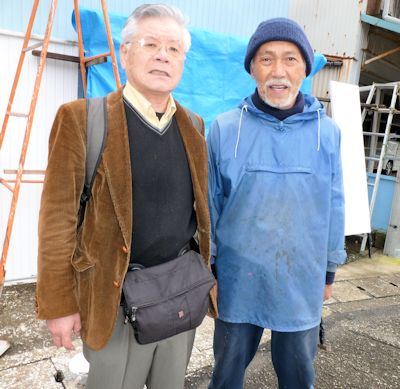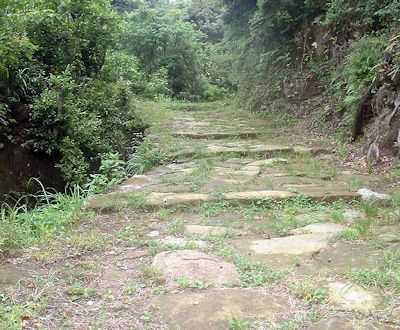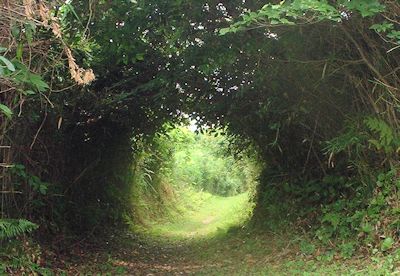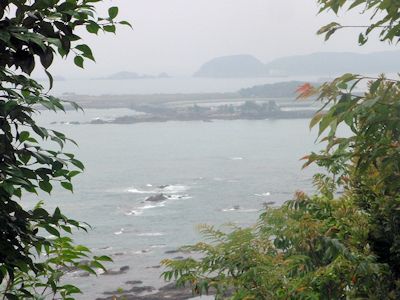|
 |
|
|
|
|
| 4. This and That |
|
|
November 25, the fourth and the last day of the trip.
The return flight from Nanki-Shirahama Airport was delayed by 20 minutes due to a bird hitting an engine.
However, it was a comfortable flight and arrived at Haneda Airport at 1:30 pm.
Our four-day trip ended with a grateful appreciation for the hospitality
of my brother and his wife Nobu-yan.

The following are some in my memory not written down yet on this trip.
|
|
|
Two Encounters
A man of "Bunsakkya" family
November 24, the third day. Finally, we have to leave Miwasaki, going back
home.
We left my brother's house and wandered to the bus stop bound for Shingu.
I had mistaken it near the unmanned Miwasaki Station. No bus stop around.
I asked an elderly man nearby, who politely said, "It used to be here
a long time ago."
I thanked him, saying "My name is Shigeru Koshiba. I came here to
Miwasaki to visit my ancestral tomb and see my brother's couple.,"
This man immediately beamed with delight and said,
"Really, you are Shigeru-san. I am Masafumi of Bunsakkya family."
According to him, two of our brothers are remote relatives. I also gradually talk in the local dialect. The new topics about my brother, my parents,......, and others that I don't know pop up one after another from his mouth.
For 10 and more minutes, we were engrossed in conversation to forget the
time.

Speaking of which, another relative's family name was "Hidoimya",
and my house was "Matsudaya". There were also such names like
"Kadaimya", "Shintaya", etc. In the old days, of father's
time, it seems the last name was popular to be called by such a family
name.
Leo-san, a chef
One happening on November 25, the last day of the trip.
Breakfast at 7:00 a.m. among Japanese, Western, and Chinese buffets.
Looking around at the table with the dishes in my hand, I noticed a cook
making an omelette. Apparently, he is not a Japanese. I talked to him.
"Good morning. How are you?"
He immediately shouted
"Fine, thanks. How are you?"
"Where are you from?"
"I'm from Czech."
Maybe a good time to rest a little, he hung out and talked with me for
a while.
What I know about the Czech Republic are only the capital Prague, Moldau
River and Smetana, the composer. Thinking of a certain wonderful country
town I stopped at while touring the area, I can't remember the name, when
he guessed.
"Isn't it Chesky Krumlov?"
That's right. That town was Chesky Krumlov. Then close conversation.
"Why do you live here in Japan?"
"My wife is a Japanese. I like Japan."
I left the place not to disturb him too much.
After eating, I looked around and saw him in a small break in the other
kitchen. He responded to the shoot with a smile. Again, he was friendly
with me and my clumsy English, boasting of his homeland of the Czech Republic
and emphasizing that he liked Japan even more.

According to the front desk, his name was Leo. I was blessed with a nice
bonus for the trip.
|
|
|
Senjojiki
a huge layer of bedrocks on the seashore
We stayed in "Hotel Senjo" on the last night, next to the scenic
spot Senjojiki in Nanki Shirahama.
It blessed us to stroll around Senjojiki before boarding the bus to the
airport. The following are extra photos there.
Senjojiki, other photos
|
|
|
Hunting cap, still there!
On this trip, until I checked in at Nanki Shirahama Airport on the last
day, I was not wearing a hat or a cap in any photo. It is rare for me to
have my head fully exposed. When I got off here on the first day, I may
have left the favorite hunting cap behind on the plane.
I checked at the JAL counter in the arrival lobby, but it was not found.
The plane had already turned around and left for Haneda.
Although I gave up, I left the airport, asking, "If you may find it,
please let me receive it at the flight on the 25th."
As I was about to finish checking in my luggage, the staff talked to me,
"This is yours, isn't it?"
Really, my hunting cap! A Borsalino bought in Milan, Italy 10 and a couple
of years ago. Involuntary, I was overjoyed.

|
|
|
Shingu Dialect
On the first day, at the hotel Harvest Nanki Tanabe, I noticed a certain
frame on the wall near the elevater hall. I took a shot as follows. It
is about the local dialect around there.
"Hishiru" and "Fuuwarui" are understandable to me,
but a little different from our Shingu or Miwasaki dialect.

The talk with my brother was almost all in Miwasaki dialect without being
conscious of it.
Returning home, I opened the book "The lecture of Shingu Dialect"
written by Mr. Jo, my former friend. Let me quote a little. Sorry all in
Japanese.
| ばたくる |
|
暴れる。じっとしていず、抵抗する様子。 |
| ひしくる |
|
悲鳴をあげること。とくに幼児。 |
| すっこい |
|
ずるい、ずる賢い、こすからい。 |
| はしかい |
|
荒っぽいこと。おとなしくない、うるさ型。 |
| まいしょうら |
|
おしまいにしましょう、やめておこう。 |
| まいかって |
|
モノが神隠しにあったように行方不明。 |
| やつす |
|
化粧をする、身ぎれいにする。 |
| ふうわりぃ |
|
みっともない、格好が悪い。 |
| くろにえる |
|
内出血で黒いあざの症状。 |
| さぶい |
|
寒い。 |
| ふてる |
|
捨てる |
| ぼちこむ |
|
地面が陥没する、穴に落ちる。 |
| わやになる |
|
すっかりむちゃくちゃになる。 |
| あばぶい |
|
まぶしい。 |
| うめる |
|
風呂で水を足して温度を下げる。 |
| ふたる |
|
溢れる。 |
|
|
Nanki-Kumano
English Introduction
The homepage "Viva, Seniors!" (中高年の元気!) has become my reason
for living.
Nearly 20 years ago, when I was enjoying mountain walking as a member of
a group, someone praised my travelogues and it encouraged me much. That's
one of why I continued to engage in writing travelogues either domestic
or overseas, essays, novels, and everything regardless of the content until
now.
Recently, I have had a wish to convey the charm of my favorite Japan to
foreigners, mostly through my domestic travelogues. One motivation is the
desire to improve my English, but as a result of experiencing being stationed
in the U.S. and enjoying traveling abroad, I also wish to convey the unique
climate and culture of Japan through my own experience to the world in
English.
The first thing for myself is "my home country." I gave priority
to Nanki Kumano of my pride. Especially the introduction of Miwasaki of
my hometown.
Nanki-Kumano has been designated as a World Heritage Site and is famous
in its own way. But Shingu City and Miwasaki are known by very few people
even in Japan.
Therefore, I made up my mind to open a square of "The Introduction
of Japan in English" and have been adding various travelogues to the
square called "English Edition".
 |
Koyazaka Slope of Kumano Ancient Road
at the Miwasaki Entrance |
 |
| A lane toward the observatory |
 |
The panorama view of the sea
around Miwasaki from the observatory |
I am going to translate this travelogue into English some day as the story
155, and add it also to the "Nanki-Kumano" and "English
Edition" squares.
|
|
| Part 4 Reading: 11' 29" |
| Total Reading: 33' 29" |
|
|
|
|
Visit to family tomb,
November 2016
End
English translation
August 15, 2022
|
|
|
|
|
|
|
|
| Close 閉じる |
|